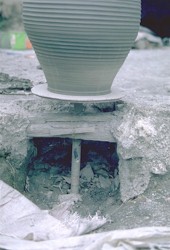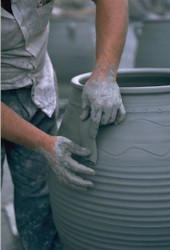 |
 |
| D.2. | Vessel Formation: | |||
Once a lump of clay has been prepared or modified to the right consistency/composition, there are a number of methods by which the potter can shape the clay into a vessel. Abu’l-Qasim only mentions throwing on a wheel, which for some clays is the principal method of formation; however with relatively non-plastic materials like stonepaste, wheel-throwing is almost impossible and therefore other techniques are favoured, especially moulding. What happens to a pot after formation (eg. paring down, glazing) often obliterates the surface traces of the technique that was used, so that they can only be seen in X-rays. While our knowledge of formation methods is frequently derived from pottery-producing cultures of today, these methods have not changed all that much over centuries (Technology Part 2: Ethnographic Approaches), and also scientific analysis can give us an insight into how particular vessels were formed (Technology Part 2: Scientific Approaches). A few actual moulds survive from Nishapur, all of unglazed, fired clay.
Common methods of constructing pottery are: pinching and/or drawing; slab-modelling; moulding; casting; coiling; throwing on a kick-wheel or a turntable. Several of these techniques may be used in one pot, for example the component parts of a stonepaste vessel may be thrown separately on a wheel and then luted together, creating a unique shape that would be hard to form on a wheel even with a plastic clay.
| D.2.a. | Hand-forming: | |
| Pinching | consists of opening up the lump of clay by inserting the thumb or fingers, then squeezing the clay between the thumb and fingers or the fingers of both hands. Repeating this action around the entire lump of clay thins and shapes it in to the desired form. It is often used for small simple vessels that can be held in the hand, or for forming the bases of larger vessels that are built up by other methods. |
| Drawing | is similar to pinching but it is used on larger vessels, and uses vertical movement to open up the lump of clay. The potter simultaneously squeezes and pinches with an upward pulling or stretching movement to raise and thin the walls of the vessel. A tool may be used to scrape the clay upward. |
| Slab-modelling | means that the vessel is constructed from more than one slab of clay. These are flattened with a rolling pin or patted by hand, then joined together into the desired shape. It is generally used to form rectangular shapes but can also be used for cylinders or very large vessels. A variant of this method is called "morsel building" in which very small lumps of clay are flattened and shaped, and joined to build the walls upward and outward. |
| Coiling | is perhaps the easiest
method of manufacturing a pot. Coils or ropes of clay are
laid on top and around each other to build up the vessel
circumference and gradually increase its height. There
are different types of coiling: ring building, segmental
coiling or spiral coiling. These are pretty
self-explanatory: in the first type, individual rings are
laid on top of each other; segmental coiling means each
ring is composed of several segments which don’t
measure the entire circumference of the pot; spiral
coiling means a long rope of clay is spiralled round the
circumference of the pot. Any or all of these techniques
can be used for the entire pot or for parts of it, where
the other parts are formed by eg. pinching, drawing or
modelling. As the pot is built up by successive coils being laid over each other, the potter squeezes or pinches the coils together to form a strong bond. The junctions of the coils are thus obliterated by treatments after the pot shape is intially formed, and it is thus difficult to see with the naked eye how the pot was formed, especially if it is subsequently glazed or covered with a slip. However, stresses may show during drying if the coils have been poorly bonded, and it is easy to see with X-ray photography that the pot has been built up with coils of clay. |
| Casting | is a variant of moulding (see below), whereby a thin suspension of fine clay in water (=a slip) is poured into a mould and allowed to stand while some of the water is absorbed by the plaster or earthenware mould; the excess slip is poured off, leaving a thin layer of fine clay which dries in the mould. |
| D.2.b. | Moulding: | |
A section of clay is rolled into a "pancake" and pressed into or over a prepared mould made of plaster or fired clay, or even everyday objects such as baskets: the clay may be applied to the exterior or the interior of a mould, and the mould may be a single unit or a two-piece mould (eg. for forming neck and body). Parting agents are used to prevent the clay from sticking to the mould (eg.ash, fine sand), however while the clay dries on the mould it shrinks away from the sides making it easier to remove when fully dry.
The mould itself may be decorated with incised or relief decoration so that when the clay is firmly pressed in it acquires the decoration in reverse: this technique is used in Chinese celadon wares. A similar technique was used by tile-makers to make relief quotations from the Qur’an. Mould-forming can later be detected on pots through the presence of seams at the juncture or edges of the mould, or a thin layer of parting agent, or a contrast in textures between the mould side (smooth) and the pressed-down or beaten side (rougher).
| D.2.c. | Throwing: | |
The type of clay prepared for throwing is usually softer and wetter than that used in hand-building techniques, as the air circulation during rotation on a potter’s wheel leads to more rapid evaporation and drying of the body. The clay is also finer-textured to minimise abrasion of the potter’s hands. Simple turntables are common, though the kick-wheel was the type of wheel most often used. This consisted of two horizontal discs of wood (or some other hard and not too heavy material), the upper one being the wheel on which the clay was thrown. This stood at about table-height or higher and the potter sat in front of it. The lower disc was the kick-wheel which the potter turned with his feet as he was throwing the clay, and the two discs were connected by a vertical shaft.
A lump of clay is placed on a wheel with its mass carefully centred, or the pot will be asymmetrical and uneven in thickness. The clay is opened by inserting fingers into the centre of the mass as it rotates. The vessel is shaped by "lifting" the clay with one hand inside and the other outside to draw the walls upward and outward, thinning them at the same time. This process is aided by centrifugal force from the spinning of the wheel. The base may be formed with a modelling tool. The vessel is cut from the wheel with a knife or wire.
Throwing "from the hump" is a variant technique in which a very large mass of clay is centred on the wheel and several vessels are thrown in succession from the top of the lump. Wheel-thrown vessels can be identified by "rilling", rhythmic grooves that spiral around the vessel walls: these may be obliterated by careful smoothing and may only be visible with X-ray photography. The undersides of the bases may bear concentric striations caused by removing the vessel with a wire/knife while the wheel is still rotating.
| D.2.d. | Combinations: | |
Different parts of a vessel may be manufactured in different stages: eg. the lower half may be moulded, the upper half coiled; the body wheel-thrown and the neck added by coiling, then smoothed by hand while the pot still rotates on the wheel. Moulding or hand-modelling is the usual technique for shaping handles, spouts, supports or decorative motifs in relief.